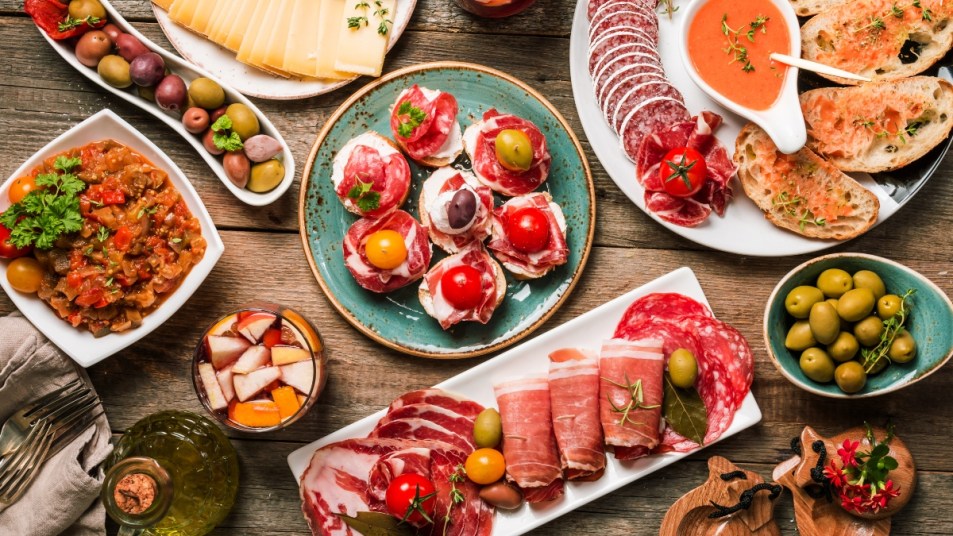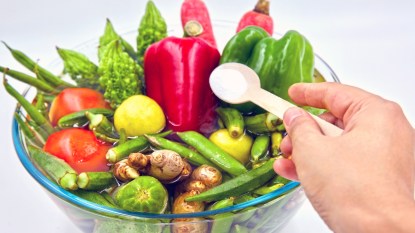Eating Tapas Style: Small Plates, Big Benefits
A tasty way to feel your best.

Foods like chips and dip, sliders, and mozzarella sticks are culinary wonders: Small, shareable plates bring people together at mealtime. Spanish tapas — small appetizers and snacks served both hot and cold —were designed with this in mind. After all, a large variety of small dishes shared with friends is a great alternative to eating one larger dish by yourself. In addition to letting you try a little bit of everything on the menu without breaking the bank, eating Spanish-style tapas has a host of other advantages. Read on to learn more about tapas, from the foods they comprise, to their benefits for body and mind.
What are tapas?
Native to Spain, tapas are small plates commonly served at bars and enjoyed with wine and beer. Ordered in large quantities and designed for sharing, their many single bites add up to a full meal. You may be thinking that tapas, appetizers, and hors d’oeuvres, sound like the same things, and you’re right that they are all small, shareable foods. However, they have several differences:
- Appetizers are small plates served as a first course in advance of a larger meal. Typically, appetizers are composed of foods that complement the main course, and they’re meant to entertain and excite diners while they wait for the delicious meal to come.
- Hors d’oeuvres are also small plates, but they’re usually served with cocktails independent of a meal. Because they are eaten while standing, they are easy to consume without utensils. The term hors d’oeuvres roughly translates to “outside the meal” in French, indicating that they are not part of a standard sit-down dinner.
- Tapas, like appetizers and hors d’oeuvres, are small plates. However, they do not need to be fingers foods, and they are not served as a precursor to a larger meal. Rather, they’re served as either standalone snacks or in sufficient quantity and variety to add up, despite being shared, to a complete meal. “Excitement tends to gather around tapas in a way that it doesn’t around appetizers,” Spanish chef Maneno Fayos told The Los Angeles Times. “It’s more of a social way of eating.” Tapas are also served in the afternoon to keep hunger at bay, as Spaniards tend to eat dinner later at night.
Where did tapas come from?
“Tapas” comes from the Spanish word tapa, which means “lid.” This meaning correlates with one of the commonly told stories behind the traditions’ origins: some say that tapas began as “small slices of meat or bread served in [Spanish] bars that patrons could use to cover their drinks to keep flies out.” Another theory is that 13th century Spanish ruler King Alfonso X recovered from a severe illness by eating small quantities of food and wine frequently throughout the day (instead of three large, sit-down meals). In response to his healing, he commanded that every bar serve food alongside alcohol. Yet another, considerably more practical explanation, is that serving tapas is simply a good business model: the promise of free food draws customers into bars; salty dishes make those crowds thirstier; thirsty crowds order more drinks. Whatever their origins, tapas continue to be a popular method of eating today.
What are traditional tapas-style foods?
Because tapas is a way of eating food, and not the name of any one specific dish, a tapa can be just about anything, as long as it’s served in small portions and shared. However, because tapas have been around for a long time and have rich Spanish roots, there are a handful of recipes that appear on almost every tapas menu. Some are as simple as a plate of olives or cured meat, while others are much more involved. Here are just a few Spanish dishes that you can find at traditional, tapas-style bars and restaurants.
Ensaladilla Rusa: This dish is like potato salad — it contains mayonnaise, tuna, hard-boiled eggs, peas, carrots, and potatoes. It’s a Russian dish that was popularized when increasing numbers of immigrants moved to Spain.
Patatas Bravas: Fried potatoes covered in a spicy tomato sauce, these are crispy on the outside and just under firm in the center.
Gambas Al Ajillo: In this dish, shrimp are sauteed in garlic and served sizzling in a cazuela (terra cotta bowl).
Calamares Fritos: These crisp, fried calamari are usually seasoned with a squeeze of fresh lemon juice and salt.
Croquetas: Here, fried dough balls are filled with creamy bechamel sauce and meat, usually Iberian ham.
Tortilla De Patatas: This thick, quiche-like dish is made of potatoes, eggs, and sometimes vegetables.
Pan Con Tomate: Literally translated as “bread with tomato,” this dish is fresh or toasted bread that’s been rubbed with tomato and raw garlic.
Pimientos De Padron: Sometimes hot and sometimes not, these blistered green Spanish peppers are seasoned with sea salt.
What are the benefits of eating tapas-style?
Though I understand the appeal of a heaping plateful of your favorite dish, there are benefits to eating tapas style instead.
Small portions can promote weight loss. “Eating from a smaller plate can make the same amount of food seem like more,” says Martha M. Henze, MPH and registered dietician. You can still clean your plate and lose weight.
The time it takes to eat helps you honor your hunger cues. Because tapas require that you try multiple dishes, and because those dishes aren’t usually brought to the table at the same time, it’s easier to take a break between bites and practice more mindful eating. This allows time for your brain to signal that your body is full, which takes 20 minutes, according to Henze.
Variety is good for your health. Tapas-style eating allows you to try a large variety of foods, instead of spending your entire meal time on just one dish. Aside from the excitement of trying new flavors and expanding your palate, incorporating more variety into your diet has benefits for your health. According to the Cleveland Clinic, varying the foods you eat promotes a well-rounded diet that’s good for gut health, increases nutrient intake, and even helps you live longer. And rotating flavors at each bite, which is easy when you have a bunch of different foods in front of you, can actually strengthen your taste buds, according to research.
Breaking bread with others is essential to our wellbeing. Since the dawn of man, communal eating has been a way to strengthen bodies, bonds, and minds simultaneously. Tapas-style eating is social at its core; it mandates sharing. And when you are sharing different foods with others, inevitably you talk: At first, about which plates are your favorites and what you’ll order next. As the night continues, you learn and laugh together, sharing memories, stories, and the most important, nonrenewable resource: time. And because everyone eats, sharing food is an equalizer that can help bridge differences and build trust. Some research even shows that sharing meals with others improves digestion, longevity, and mental health. So call up some friends for a tapas night — you won’t regret it.
Whether you enjoy traditional, Spanish-style tapas foods, or you host your own tapas party with American bites, you’re bound to enjoy supping on small plates with friends. As the Spanish say, ¡buen provecho!













